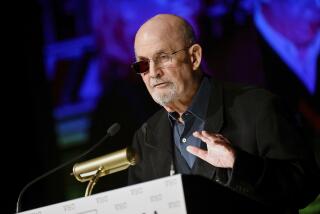Picking up the pieces
Here are the facts: On “Friday, February 8, 1991, at around 6:30 in the morning,” Joan Wickersham’s father, Paul, committed suicide by shooting himself in the head. He was 61, a failing businessman, with a lifestyle he could not afford and the burdens of a troubled past. Born in Germany and raised in New York, he had been beaten -- to the point of broken bones -- by his father; as an adult, he seemed touched by an unbridgeable distance, as if solace were not a possibility in his world. On the last morning of his life, he dressed for work, then made coffee for his wife before retreating to his study and ending his existence behind closed doors.
“After he died,” his daughter recalls in her remarkable memoir “The Suicide Index: Putting My Father’s Death in Order,” “when we learned that the gun had malfunctioned slightly -- it put a bullet into his brain but did not fire with enough force to blow his head apart as might have been expected -- my mother said, ‘Jesus Christ, he couldn’t even do that right.’ ”
All these details add up to a not-uncommon type of pathos, a life defined by loneliness and disassociation, disappointment and not enough love. Yet “The Suicide Index” draws its power not so much from the misery of Wickersham’s father as from the confused half-grief, half-anger of the family he left behind. Late in the book, in a chapter gathering quotations on the subject, Wickersham cites William Maxwell, from “The Folded Leaf” -- “The suicide doesn’t go alone, he takes everybody with him” -- and then Flaubert: “We want to die because we cannot cause others to die, and every suicide is perhaps a repressed assassination.” Somewhere in the middle distance between these observations her own inquiry resides.
For Wickersham, her father’s death blows a hole in the order of the universe; during much of the following decade, she is numb, unable to access her emotions, unavailable to her husband, to her kids. Her eldest son, 3 at the time of his grandfather’s suicide, grows up to be a depressed teenager, “seeing a psychiatrist, taking medication. Some days he can’t get out of bed.” This is loaded material, and not just because of what the author reveals about her own child. No, more to the point is the way she exposes the whole messy territory of inheritance, of heritage, of what our families leave us, the treacherous trail of genetics and psychology and unhappiness, the legacy of all those generations as they play out in ways that we can see and ways that we will never see across the patterns of our lives.
Because of this, Wickersham understands that the facts are inadequate: They tell us the what without getting at the why. And yet, the why is unknowable to anyone other than the suicide. How, then, to write about it? Wickersham develops an ingenious solution, framing her memoir as an index, in which chapters are grouped less in terms of chronology than theme. “Up until now,” she writes in an early passage, “I’ve been pretty much sticking to a standard linear way of telling the story of my father’s suicide. I’ve adhered to chronology: first this happened, then that happened. . . . I’m not going to be able to keep it up.”
That’s a startling admission, true in a way that transcends mere recollection, and it opens “The Suicide Index” to the morass of emotions that her father’s act stirs up. This one moment, she tells us, “had made a permanent shift in how we saw the world, in what we were certain of and what we were aware of not knowing. There really was no way to tell for sure if a man was in a corner. And what that man, if he ever got into a corner, might do.”
Implicit in such a statement is the question of what we might do, of how much any one of us can take. For Wickersham, it’s all tied up in her memories of her father, which now come weighted, as if they were clues in a puzzle she can’t figure out. The indexing idea, then, is both an admission of this inability and an attempt to work around it: How better to comprehend the incomprehensible than by giving it a shape, an order, it did not -- could not -- have in actual life?
There is, of course, a risk here, that the structure of the book might become a gimmick. Wickersham understands this, also; “I have to be careful not to make it too orderly,” she declares. Yet in the end, she arrives at an almost perfect balance, producing a survivor’s story, a portrait of suicide from the outside, one that finds clarity in its inability to be clarified.
Suicide, Wickersham writes, is “the only cause of death that can be used as a noun to describe the dead person. If you die of cancer you are not called ‘a cancer.’ If someone else shoots you, you are not referred to as ‘a murder.’
“But if you shoot yourself, you are labeled as a suicide.
“Your death becomes your definition.”
--
David L. Ulin is book editor of The Times.
More to Read
Sign up for our Book Club newsletter
Get the latest news, events and more from the Los Angeles Times Book Club, and help us get L.A. reading and talking.
You may occasionally receive promotional content from the Los Angeles Times.







